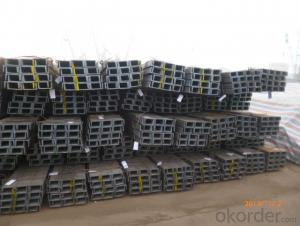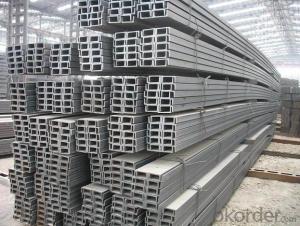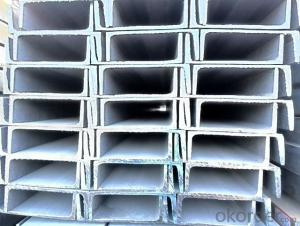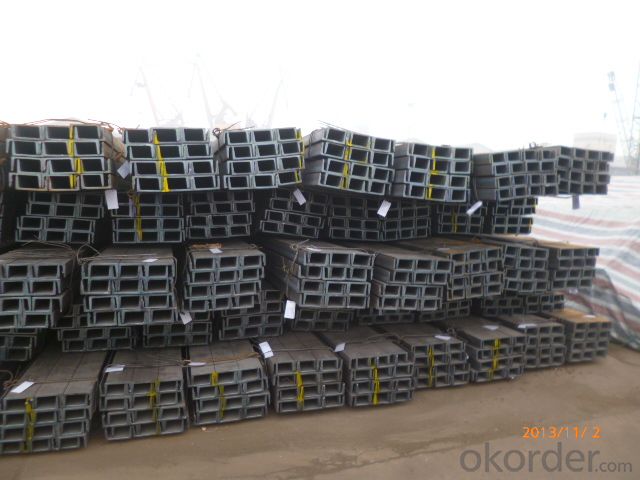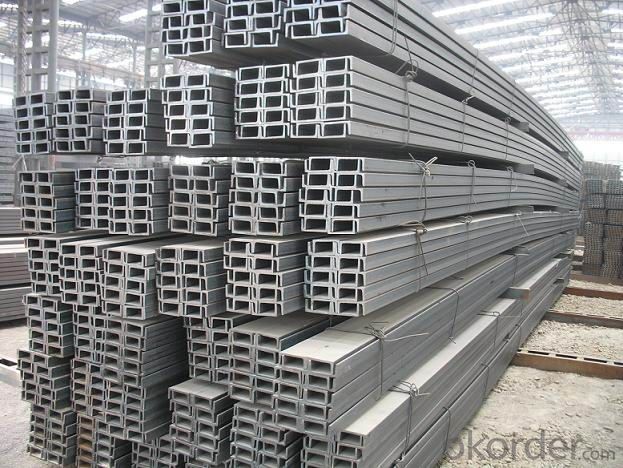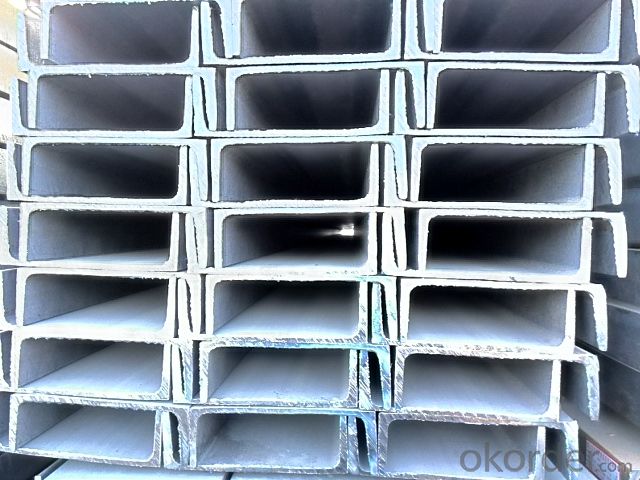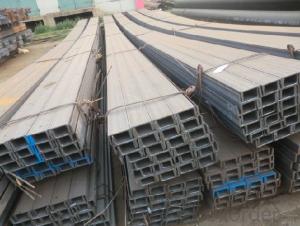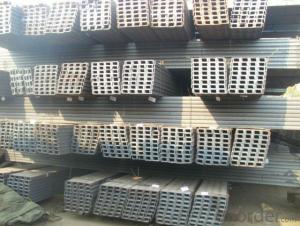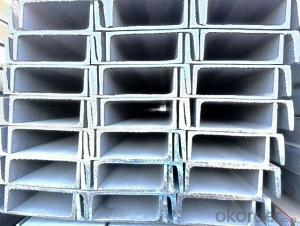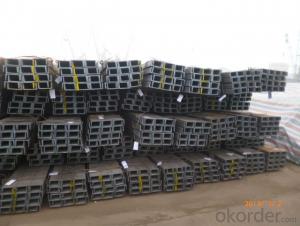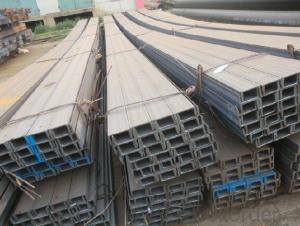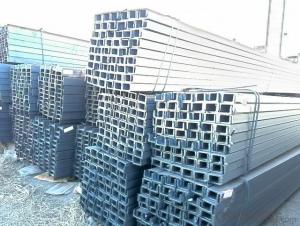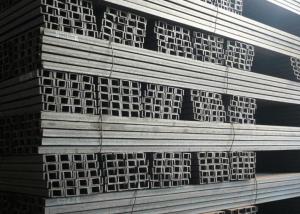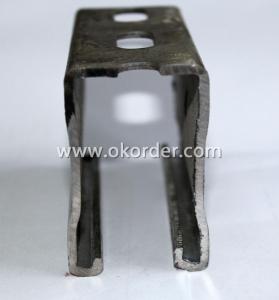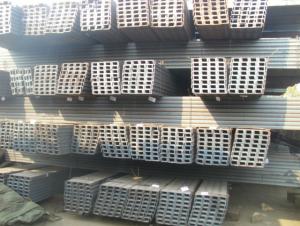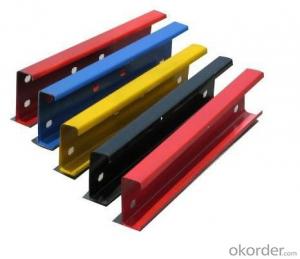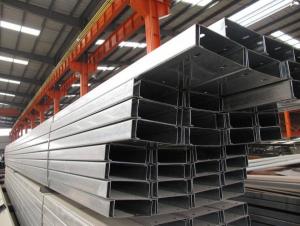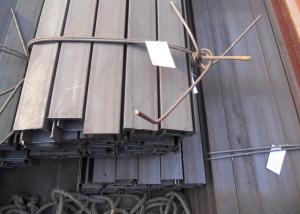Hot Rolled JIS U-Channels with Lowest Price
- Loading Port:
- Tianjin
- Payment Terms:
- TT OR LC
- Min Order Qty:
- 25 m.t
- Supply Capability:
- 10000 m.t/month
OKorder Service Pledge
OKorder Financial Service
You Might Also Like
Specification
OKorder is offering high quality Hot Rolled Steel U-Channels at great prices with worldwide shipping. Our supplier is a world-class manufacturer of steel, with our products utilized the world over. OKorder annually supplies products to European, North American and Asian markets. We provide quotations within 24 hours of receiving an inquiry and guarantee competitive prices.
Product Applications:
The MS Channel can be applied to construction of warehouses, workshops, sport stadiums and car parks etc.The hot rolled channel steel belongs to carbon structural steel which is applied to in the field of construction and machinery.In details, the hot rolled channel steel is usually used for arch-itechtural structure, and they could be welded in order to support or hang a vari-ety of facilities. They are also usually used in combination with I beam. Generally,the hot rolled channel steel we supply must possess perfect welding property, riveting property and mechanical property and so on.
Product Advantages:
OKorder's Steel U-Channels are durable, strong, and resist corrosion.
Main Product Features:
· Premium quality
· Prompt delivery & seaworthy packing (30 days after receiving deposit)
· Corrosion resistance
· Can be recycled and reused
· Mill test certification
· Professional Service
· Competitive pricing
Product Specifications:
1.We supply high quality MS Channel at reasonable price, including Chinese standard, Japanese standard and so on.
2. The detailed sections of MS Channel as per GB standard.are shown in the table-1:
GB U CHANNEL | Standard | Sectional | Dimension |
| Mass: |
(mm) | (mm) | (mm) | (mm) | ||
50X37 | 50 | 37 | 4.50 | 7.0 | 5.438 |
63X40 | 63 | 40 | 4.80 | 7.5 | 6.634 |
80x43 | 80 | 43 | 5.00 | 8.0 | 8.045 |
100x48 | 100 | 48 | 5.30 | 8.5 | 10.007 |
120x53 | 120 | 53 | 5.50 | 9.0 | 12.059 |
140x58 | 140 | 58 | 6.00 | 9.5 | 14.535 |
140x60 | 140 | 60 | 8.00 | 9.5 | 16.733 |
160x63 | 160 | 63 | 6.50 | 10.0 | 17.240 |
160x65 | 160 | 65 | 8.50 | 10.0 | 19.752 |
180x68 | 180 | 68 | 7.00 | 10.5 | 20.174 |
180x70 | 180 | 70 | 9.00 | 10.5 | 23.000 |
200x73 | 200 | 73 | 7.00 | 11.0 | 22.637 |
200x75 | 200 | 75 | 9.00 | 11.0 | 25.777 |
220x77 | 220 | 77 | 7.00 | 11.5 | 24.999 |
220x79 | 220 | 79 | 9.00 | 11.5 | 28.453 |
250x78 | 250 | 78 | 7.00 | 12.0 | 27.410 |
250x80 | 250 | 80 | 9.00 | 12.0 | 31.335 |
250x82 | 250 | 82 | 11.00 | 12.0 | 35.260 |
280x82 | 280 | 82 | 7.50 | 12.5 | 31.427 |
280x84 | 280 | 84 | 9.50 | 12.5 | 35.823 |
280x86 | 280 | 86 | 11.50 | 12.5 | 40.219 |
300x85 | 300 | 85 | 7.50 | 13.5 | 34.463 |
300x87 | 300 | 87 | 9.50 | 13.5 | 39.173 |
300x89 | 300 | 89 | 11.50 | 13.5 | 43.883 |
Table-1
FAQ:
Q1: Why buy Materials & Equipment from OKorder.com?
A1: All products are carefully selected from China's most reliable manufacturing enterprises. Through its ISO certifications, OKorder.com adheres to the highest standards and a commitment to supply chain safety and customer satisfaction. We can guarantee the quality!
Q2:What's your payment terms ?
A2: We can accept T/T,LC at sight and time LC.
Q3: Can you offer the third part inspection certificates ?
A3: Yes, we can apply third part inspection before shipping, such as SGS, BV, etc .
Images:
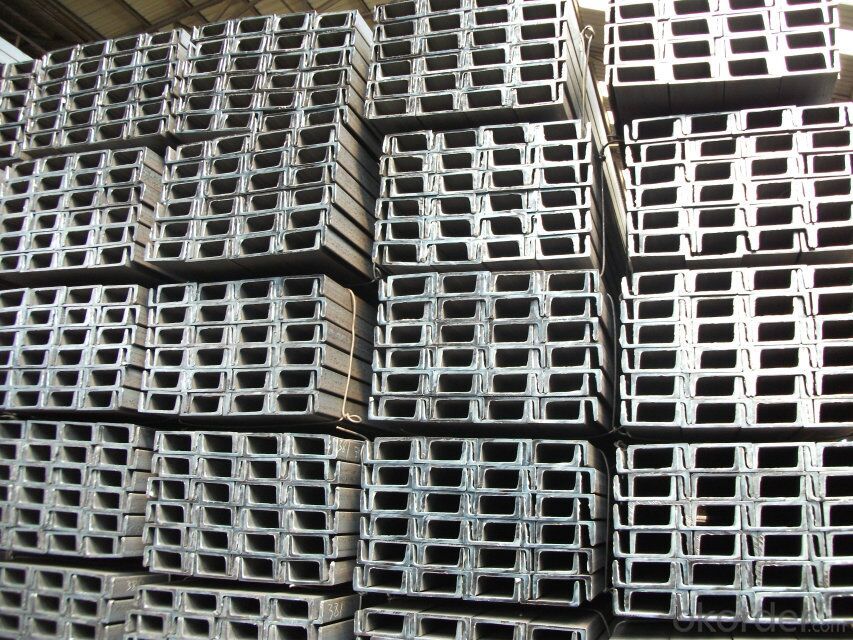
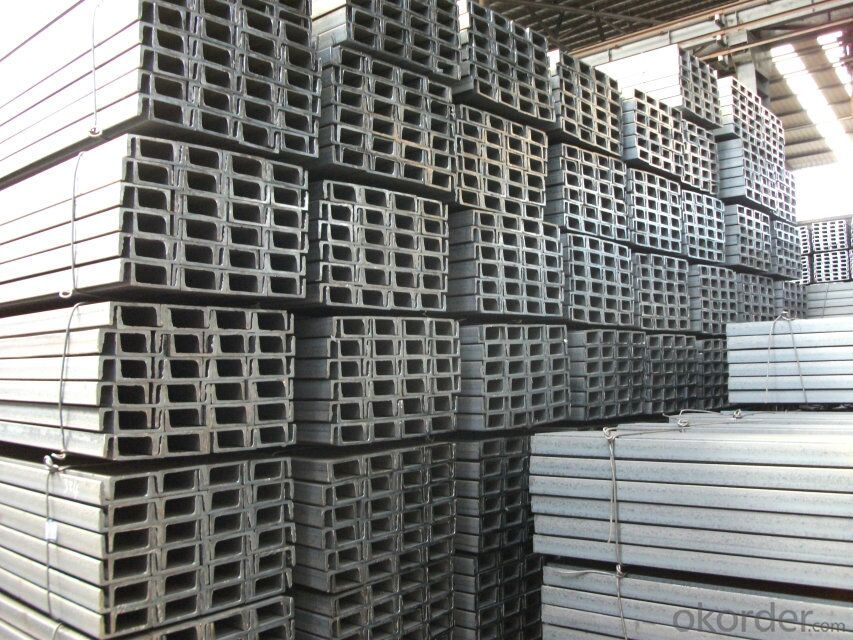
- Q: Is outside building protection single row bent with cantilever steel instead of channel steel?
- Construction of single door rack erection of cantilever I-beam steel can not be used instead of steel, because the provisions of article 6.10.2 JGJ130-2011 "construction of steel tubular scaffold safety technical specifications" cantilever beam application of biaxial symmetry,...... steel beams shall not be less than 160mm. Therefore, the channel shall not be used, the cross section is asymmetrical, and the cantilever bent, the cross section is more likely to be unstable.
- Q: What is the typical lifespan of steel channels?
- The typical lifespan of steel channels can vary depending on various factors such as the quality of the steel, environmental conditions, and maintenance practices. However, with proper care and maintenance, steel channels can have a lifespan of several decades or even longer.
- Q: Can steel channels be used in infrastructure projects?
- Yes, steel channels can be used in infrastructure projects. Steel channels are a versatile and commonly used structural component in construction and infrastructure projects. They are often used to provide support and stability to various structures, such as bridges, buildings, and highways. Steel channels offer several advantages that make them suitable for infrastructure projects. Firstly, they have high strength and durability, which makes them capable of withstanding heavy loads and extreme weather conditions. This ensures the long-term integrity and stability of the infrastructure. Additionally, steel channels can be easily fabricated and customized to meet specific project requirements. They are available in various sizes, shapes, and thicknesses, allowing engineers and architects to design and construct structures with precision. Furthermore, steel channels have excellent corrosion resistance properties. This is crucial in infrastructure projects, especially those exposed to moisture or harsh environmental conditions. Steel channels can be galvanized or coated with protective layers to prevent rust and corrosion, thereby extending their lifespan. Moreover, steel channels provide cost-efficiency. Compared to other construction materials, such as concrete or wood, steel channels have a longer lifespan and require less maintenance. This reduces the overall maintenance and replacement costs of infrastructure projects, making them a cost-effective choice. In conclusion, steel channels are widely used in infrastructure projects due to their strength, durability, customization options, corrosion resistance, and cost-efficiency. They play a crucial role in providing support and stability to various structures, making them a reliable choice for engineers and architects involved in infrastructure development.
- Q: How do steel channels contribute to the overall safety of a building?
- A building's overall safety greatly depends on the presence of steel channels, as they are an integral part of the structure. These structural members are crucial for providing stability, strength, and support to the entire building. To begin with, steel channels evenly distribute the weight and loads of the building throughout the structure. By serving as load-bearing members, they ensure that the weight of the building is transferred to the foundation, thus maintaining stability and enabling the structure to withstand external forces like wind, seismic activity, or heavy snow loads. Additionally, steel channels are specifically designed to resist bending or buckling, which significantly enhances the structural integrity of the building. In areas prone to earthquakes or high winds, this resistance to deformation is of utmost importance, as it helps prevent the structure from collapsing during such events. Moreover, steel channels contribute to fire safety in buildings. Unlike other construction materials, steel possesses excellent fire-resistant properties. It does not burn, melt, or release toxic gases when exposed to high temperatures. Consequently, steel channels act as a safeguard, preventing the spread of fire and ensuring the building's structural stability, thereby allowing occupants ample time to evacuate safely. Furthermore, steel channels are highly durable and resistant to corrosion. This durability guarantees that the building maintains its strength and stability over time, minimizing the risk of structural failure due to material degradation. It also reduces the need for frequent maintenance and repairs, thus enhancing the building's long-term safety. To summarize, steel channels play a vital role in ensuring the overall safety of a building. They provide stability, strength, and support, evenly distribute loads, resist bending and buckling, and contribute to fire safety. Their durability and corrosion resistance further enhance the building's long-term safety. Therefore, incorporating steel channels into a building's construction is essential for creating a secure and safe environment for its occupants.
- Q: What are the advantages of using steel channels in construction?
- Using steel channels in construction offers numerous benefits. Firstly, steel channels possess incredible strength and durability. They have a high strength-to-weight ratio, meaning they can support heavy loads without adding unnecessary weight to the structure. This makes them ideal for a wide range of construction projects, including bridges, buildings, and infrastructure. Secondly, steel channels are highly resistant to corrosion. Unlike materials like wood or concrete, steel channels do not rot, warp, or degrade over time. They can withstand exposure to harsh weather conditions, chemicals, and moisture, making them suitable for both indoor and outdoor applications. Moreover, steel channels offer exceptional versatility in design and construction. They come in various sizes, shapes, and configurations, allowing for flexible use in different applications. Steel channels can be easily fabricated and customized to meet specific project requirements, making them adaptable to a wide range of construction needs. Furthermore, steel channels prove to be cost-effective in the long run. Although the initial cost of steel channels may be higher than that of other materials, their strength, durability, and low maintenance requirements result in lower life-cycle costs. They do not require frequent repairs or replacements, reducing overall maintenance and replacement expenses over time. Additionally, steel channels exhibit fire resistance. Being a non-combustible material, steel does not contribute to the spread of fire. In the event of a fire, steel channels can provide structural stability and integrity, ensuring the safety of the building and its occupants. Lastly, steel channels are environmentally friendly. Steel is one of the most recycled materials globally, and utilizing steel channels in construction helps reduce the demand for new raw materials. Furthermore, steel is energy-efficient, requiring less energy to produce compared to other construction materials. In conclusion, the advantages of employing steel channels in construction encompass their strength, durability, resistance to corrosion, versatility, cost-effectiveness, fire resistance, and environmental friendliness. These qualities position steel channels as the preferred choice for diverse construction projects, offering long-term benefits and guaranteeing the integrity and safety of the structures in which they are utilized.
- Q: Can steel channels be used in load-bearing walls?
- Yes, steel channels can be used in load-bearing walls. Steel channels are commonly used for structural support in construction projects due to their high strength-to-weight ratio. They are often employed in load-bearing walls to provide additional support and stability. Steel channels offer excellent load-bearing capabilities, as they can withstand heavy vertical and horizontal loads. Additionally, they can be easily integrated into the wall structure, making them a practical choice for load-bearing applications. However, it is important to consult with a structural engineer or a construction professional to ensure that the specific steel channels being used meet the required load-bearing capacities and comply with building codes and regulations.
- Q: What are the fire resistance properties of steel channels?
- Steel channels have excellent fire resistance properties due to their inherent material characteristics. Steel is a non-combustible material, meaning it does not burn or contribute to the spread of fire. This makes steel channels highly resistant to fire and heat, allowing them to maintain their structural integrity even under extreme temperatures. Steel channels also have a high melting point, typically around 1370 degrees Celsius (2500 degrees Fahrenheit), which further enhances their fire resistance. This means that steel channels can withstand intense heat without deforming or collapsing, making them a reliable choice for applications where fire resistance is crucial. In addition to their high melting point, steel channels can form a protective layer of oxide during a fire, which acts as a shield against further heat transfer. This layer of oxide, known as scale, acts as insulation, slowing down the heat transfer from the fire to the steel channel. It helps maintain the structural strength of the steel channel for a longer period of time, providing valuable time for evacuation or firefighting efforts. Furthermore, steel channels are often used in fire-rated assemblies, where they are combined with other fire-resistant materials like fire-rated gypsum board or intumescent coatings. These assemblies are specially designed to provide enhanced fire resistance and can withstand fire for extended periods, offering additional protection to the steel channels and the overall structure. Overall, steel channels have excellent fire resistance properties due to their non-combustible nature, high melting point, formation of a protective oxide layer, and their compatibility with fire-rated assemblies. These properties make steel channels a reliable choice for various applications where fire safety is a concern, such as in building construction, industrial facilities, and infrastructure projects.
- Q: Can the bypass of the overhanging layer on the site be made of channel steel? How can I put the channel steel, if possible?
- Reinforcement measures shall be taken if the floor thickness is less than 120mm. 6.10.9 the cantilever beam spacing shall be set by the vertical distance of the vertical pole of the cantilever frame, and each vertical distance shall be provided with one root. 6.10.10 the outer bracing of the cantilever shall be set up from bottom to top. The scissors support shall comply with the provisions of articles 6.6.2 and 6.6.5 of this code.
- Q: Can steel channels be used in the construction of staircases?
- Yes, steel channels can be used in the construction of staircases. Steel channels are structural components that provide strength and support, making them suitable for various construction applications, including staircases. Steel channels can be used as stringers, which are the main structural members that support the treads and risers of a staircase. They can also be used as support beams or handrails, providing stability and safety. Steel channels are durable, resistant to corrosion, and have high load-bearing capacity, making them a popular choice for staircase construction in both residential and commercial buildings. Additionally, steel channels can be customized and fabricated to meet specific design requirements, allowing for versatility and creativity in staircase design.
- Q: What are the typical lengths of steel channels?
- Steel channels come in a range of lengths depending on the manufacturer and their intended purpose. Generally, you can find them in standard sizes between 20 feet (6.1 meters) and 40 feet (12.2 meters). These standard lengths are commonly utilized in construction projects for structural support, framing, and bracing. Moreover, manufacturers may offer tailored cutting services to accommodate specific length requirements for individual projects.
Send your message to us
Hot Rolled JIS U-Channels with Lowest Price
- Loading Port:
- Tianjin
- Payment Terms:
- TT OR LC
- Min Order Qty:
- 25 m.t
- Supply Capability:
- 10000 m.t/month
OKorder Service Pledge
OKorder Financial Service
Similar products
Hot products
Hot Searches
Related keywords
